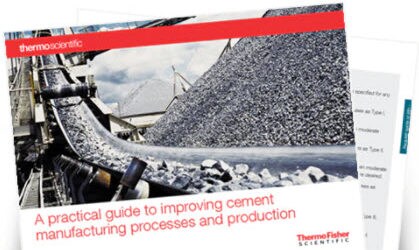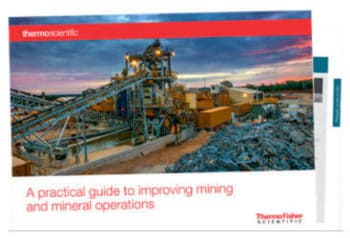In the world of cement production, precision is key. Getting the elemental composition just right is crucial for maintaining high-quality standards and meeting regulatory requirements. While X-ray fluorescence (XRF) has been a go-to method for years, Prompt Gamma Neutron Activation Analysis (PGNAA) is another important elemental technology, especially when used alongside XRF, to boost efficiency and sustainability.
So, what is PGNAA?
PGNAA works by bombarding sample materials with neutrons. This technique needs a neutron source, traditionally provided by the radio-isotope Californium-252. But thanks to advancements, we can now use a compact linear accelerator, or neutron generator, to generate neutrons electrically. When these deeply penetrating neutrons interact with the atomic nucleus of the elements in the sample, they emit secondary-prompt high-energy (MeV) gamma rays, with the exact energy levels of the gamma rays dependent on the sample’s elements. These gamma rays are then captured and measured using a high-resolution gamma-ray spectrometer where they are classified by energy and abundance. The resulting gamma ray spectrum gives us a detailed look at the elemental makeup of the sample. Each element emits a unique gamma-ray signature, which PGNAA uses to identify and quantify elements within the material.
See additional information on PGNAA technology.
Why PGNAA is great for cement production
PGNAA offers a thorough analysis by penetrating the entire cross-section of raw material on the conveyor belt. In a properly designed analyzer, this allows for continuous, minute-by-minute measurements across the entire material stream, ensuring uniformity and accuracy. Unlike surface analysis technologies such as XRF and X-ray diffraction (XRD), which measure limited depths and areas, PGNAA reduces sample errors by providing a robust measurement of the entire contents of the conveyor belt, which can then be used to produce a significant reduction in the variability in material quality.
Enhancing stockpile and raw mix control
With increasing demands from customers and regulators, cement producers are turning to PGNAA cross belt analyzers. These analyzers provide essential elemental composition data that boost quality control and process efficiency while providing energy savings and waste reduction. By closely monitoring and controlling raw materials, producers can ensure the quality and consistency of the final product. Variances in raw material quality or improper blending can lead to faulty concrete and significant construction issues. PGNAA helps mitigate these risks by providing accurate and timely information about the raw materials, thereby providing a valuable and trustworthy process sensor for reducing energy costs and material waste.
Real-time analysis with PGNAA
Traditional cement plants rely on offline sampling and lab analysis, which can introduce errors and cause delays. PGNAA analyzers, installed directly on the conveyor belt, enable continuous real-time measurement, eliminating the need for transfer towers and reducing associated construction and maintenance costs. This continuous monitoring enables the correct sorting and blending of raw materials, enhancing overall process optimization. Real-time PGNAA data, when synchronized with XRF lab results using specialized mining lab software , ensures both systems are aligned and producing consistent results. (Read a success story of a cement processing plant that implemented a cross-belt analyzer with PGNAA technology.)
Hot topic in cement production: Sustainability and reducing carbon footprint
Lately, the cement industry has been under pressure to adopt more sustainable practices and cut down on carbon emissions. This is yet another area where PGNAA can make a significant impact in a multiple ways. By providing precise elemental composition data, PGNAA helps cement plant operators optimize the raw mix and clinker production process. This improves energy efficiency and leads to significant energy savings, which is crucial for reducing the industry’s carbon footprint.
PGNAA can help reduce carbon emissions in other ways too. On-line analysis via PGNAA in a cement plant provides the means to make use of supplementary cementitious materials (SCMs) like fly ash, slag, and natural pozzolans, which generate fewer carbon emissions than traditional clinker. (Pozzolans are a group of materials that react with water and calcium hydroxide to create cementitious compounds.) PGNAA is an essential tool that allows these alternative materials to be accurately blended to achieve desired properties in the final product.
Additional carbon-centric processes can also be aided by PGNAA: Biomass and waste-derived fuels can be monitored and controlled, ensuring that their elemental compositions meet necessary standards, while the development of carbon capture and storage (CCS) methods can be facilitated by PGNAA’s ability to provide precise data on the chemical composition of raw materials and emissions.
See more insights on sustainable practices in cement production, including free actionable strategies for greener, cost-effective cement manufacturing.
Wrap up and Resources
PGNAA is transforming cement production by providing accurate, real-time elemental analysis that enhances quality control, process efficiency, and sustainability. As the industry continues to evolve, integrating PGNAA with other advanced technologies will be key to meeting future challenges and achieving long-term sustainability goals.
- Additional information on PGNAA technology
- Success story: Building green mines to deliver economic and social benefits
- Thermo Scientific PGNAA analyzers for cement analysis
- Cement production technologies and equipment.
Editor’s Note:
This article was originally published on Jun 17, 2014, with Darrell Leetham named as author. It has been substantially updated and refreshed with the latest industry information.






Wonderful piece of information. Am a product Engineer at Dangote Industries Zambia Limited and am using PGNAA..Real wonderful information. ..
wonderful piece of technology